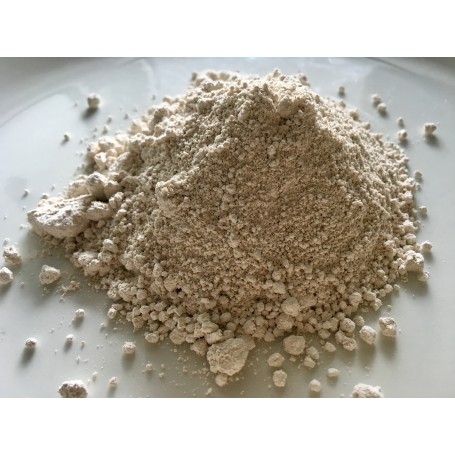Diatomaceous earth
Diatomaceous earth (purified / food graded) and Diatom (crude / feed graded)
What is diatomaceous earth?
Diatomaceous earth is a non-toxic substance made from crushed diatom fossils. Diatoms also known as diatom are a class of single-cell algae with an external skeleton of pebble. The skeleton consists of two lids of superimposed shells of silica, found in freshwater, brackish water and salt water. The silica shells remain in the sediment after the cells die. There are around 10,000 different types of diatoms, the size varies from 10 to 100 micrometers. Diatomaceous earth is 100% natural and mined from the bottom of rivers, lakes and seas. It is also called: silica, silica gel, silicon, silicon dioxide, silicea, E551 and dissolved in water: called silica.
The difference between the two:
The purified diatomaceous earth has turned white. This can be used both indoors and outdoors, in the garden and animal enclosures for controlling insects, fleas, lice, ants, worms etc.
The crude diatomaceous earth (Diatom) is cream in color. This is suitable for animals to eat (E551c) and against pests. The Diatom always measures the best for the horses, which is why we only sell the Diatom. You can compare the effect, only there is more calcium carbonate in the Diatom.
Unique properties of diatomaceous earth:
-High porosity: up to 85% of the volume of diatomaceous earth is made from tiny interconnected holes and grooves.
-High absorption: the crude diatomaceous earth can absorb up to 1X its own weight in moisture. The purified diatomaceous earth can absorb up to 2x its own weight in moisture.
- Large surface area: diatomaceous earth particles have a very irregular shape, common thorny structure and pit-like spots. diatomaceous earth particles have an average diameter of 5 to 20 microns, but have an area that is many times larger than minerals of the same size.
|
component |
Diatom (feed graded) |
Purified diatom (food graded) |
|
SiO2 |
70,3% |
94,2% |
|
Co3CA |
27,7% |
|
|
Al2O3 |
1,11% |
2,5% |
|
Fe2O3 |
|
0,9% |
|
CaO |
|
0,5% |
|
K2O |
|
0,4% |
|
So3 |
|
0,4% |
|
MgO |
0,42% |
0,3% |
|
P2O5 |
|
0,3% |
|
TiO2 |
|
0,2% |
|
Na2O |
|
0,2% |
|
Mn2O3 |
|
0,1% |
The purified diatomaceous earth (food graded):
The purified diatomaceous earth is an acaricide (a pesticide from a phytopharmaceutical preparation) and an insecticide for (professional) users to limit the damage mainly caused by lice (red mite), but also others such as ants, fleas, mites. The purified diatomaceous earth has been included by the EU in Article 95 (list of biocidal active ingredients). Because diatomaceous earth is a natural product, the insects cannot become immune to it. Diatomaceous earth has a worse effect on insect eggs and puppets, it is hard to get through the hard shell of insects at this stage of life. Diatomaceous earth has a lot of effect on the larvae and adult insects because they have a softer skin / shell.
Use
General for inside and outside: Sprinkle a thin layer where the vermin is, under gas stoves, sinks, window, door openings, garden path, soil etc. Repeat if necessary.
Fleas: Sprinkle the dogs and cat rugs / blankets thoroughly. Diatomaceous earth is also very effective if it is rubbed in the fur of a dog or cat. Repeat it after 3 days.
Lice / mites: Sprinkle the diatomaceous earth on the places where the lice / mites are on the animal and rub it in between the feathers and the fur. Also sprinkle it on the litter and in laying nests, or baskets. For birds, the diatomaceous earth can be mixed with the bath water. The diatomaceous earth enters between the feathers during bathing.
Fly:Flies do not like an environment with diatomaceous earth.
Snails: The diatomaceous earth can also be used to ward off (naked) snails. For this, sprinkle between the plants. If the diatomaceous earth gets wet, the effect is reduced. Once dried up, the effect recovers.
Ants: Sprinkle diatomaceous earth at the entrance to the ant's nest. When the ants go back to their nest, they take it with them on their legs and spread it through the entire nest.
Anti-pest agent in animal enclosures
Sprinkle the diatomaceous earth in places where pests are common, in laying nests, cracks and seams on perches, or mix it through the litter. If the wall is rough, the diatomaceous earth can be powdered with a brush on the wall. Recommended amount is approximately 20 - 25 grams per m2.
The diatomaceous earth can also be mixed with water and can then be sprayed into the cracks and seams of the animal enclosures. Recommended mixing ratio is 10-15%. Depending on the syringe to be used and the vermin outbreak, more or less diatomaceous earth can be mixed with the water. After the water evaporates, the diatomaceous earth remains on the sprayed areas and does its job. The diatomaceous earth is active as long as it is present in the cage.
The crude diatomaceous earth (Diatom / feed graded)
Food additive as an anti-pest agent
The diatomaceous earth is used as a food additive for: cows, calves, horses, sheep, goats, pigs, rabbits, chickens, turkeys, ducks, dogs, cats, pigeons and other pets.
The diatomaceous earth has been used for decades as a wormer in the digestive tract of animals. For an optimal result, the diatomaceous earth must be provided long enough so that all the eggs that have just been laid have hatched, because the diatomaceous earth does not come through the hard eggshell of the worms. The advice is to provide diatomaceous earth for at least 60 days in the general dose of 2% of the dry feed weight the animal eats. The diatomaceous earth fights the insects and parasites, because it penetrates the hard armor of the insects and parasites. Holes will then appear in the insect's armor, causing them to dry out. The larvae are controlled in the same way.
Recommended quantities per animal species:
• Horses: 2% of the total weight of the daily portion of food. (10-30. Per day) Advice pony 5-8 g, horse 10-15 g, cure lasts about 2 months maintenance dose with long use 5 g pd
• Dogs: 1 tablespoon in the daily food for dogs heavier than 25 kg. Small dogs: 1 teaspoon (young dogs from 6 months of medium-sized breeds or larger). For smaller young dogs 1/2 teaspoon.
• Cats: 1 teaspoon in the daily food.
• Rabbits: For the small and middle breeds; ¼ teaspoon in the daily food. ½ teaspoon for large varieties.
• Guinea pigs: ¼ teaspoon in daily food.
PAY ATTENTION! Do not give Diatom to small pregnant animals such as cats, guinea pigs, hamsters, etc.
Administering as a mineral supplement
The crude diatomaceous earth contains a wide range of natural minerals such as: calcium, magnesium, iron, phosphates, sodium, titanium, potassium, silicon, aluminum, etc.
The diatomaceous earth consists of 150 million year old single-celled shellfish with a skeleton of almost 100% silicon. Within naturopathy, silicon is seen as an enhancer to the entire system, therefore indispensable to make treatment a success. High concentrations of silicon can be found in the body in the connective tissue and the tissues derived from it such as bone, cartilage, tendons, skin, hair, hooves, blood and lymphatic vessels, liver, kidneys and lungs. Silicon supports the strengthening of the connective tissue by its ability to bind water. Horses with diarrhea or water after the manure have also benefited a lot from the Diatom.
A positive water balance guarantees that sufficient nutrients are absorbed and helps connective tissue and blood vessels to preserve their elasticity. Because there are fewer minerals in today's roughage, the diatomaceous earth is a good addition to food.
Further effect in food
- It acts as an anti-caking agent which makes the food particles stay separate from each other. This allows optimum nutritional intake, both bacterial and enzymatic.
- Improves protein digestion, prevents ammonia development.
- Helps strengthen ligaments and tendons
- Prevents eating sand or licking.
- Dehydrates the stomach and intestinal environment and protects and improves the stomach and intestinal wall condition, indirectly this has a preventative effect on intestinal parasites. In many cases, it removes prolonged diarrhea and water after the manure.
Protective measures
During use, wear gloves, glasses and a dust mask as a pesticide.
Measures
- Upon inhalation; moves the person in question to fresh air. If irritation occurs, consult a doctor.
- Skin contact; wash your hands with soap and water. If irritation occurs, consult a doctor.
- Eye contact; rinse thoroughly with plenty of water, also under the eyelids. If eye irritation persists, consult a doctor.
- Ingestion; no treatment required.
Sources: De Baroen and various public internet publications


